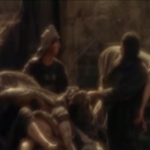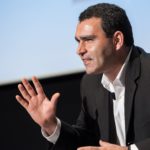An apology is in order. Probably not the only one that you’ll see from me on this blog but certainly one that is a long overdue. This one goes out to the thousands of public relations professionals, particularly the ones who almost always find a way to plant the seed that becomes a story, who uncover the news when others just see a plain old brief, who instinctually know a potential buzz machine from the proverbial blind alley. To these fine folk who helped drive the success of many of Renegade’s classic guerrilla marketing successes (BankCab anyone?), I officially apologize for omitting Public Relations as an Element in my book, The CMO’s Periodic Table: A Renegade’s Guide to Marketing.
Please note that this was not a conscious omission but rather a statistical anomaly. In retrospect, it seems impossible that PR wouldn’t become front and center in one of the over 150 interviews with senior marketers I conducted prior to finishing the book. To make amends, not that any of you are all that upset or not used to receding from the marketing spotlight, I am thrilled to present part 1 of my interview with Caralene Robinson, CMO at Vh1. A recipient of last year’s CMO Award for Creativity, Caralene was kind enough to share her thoughts on the importance of PR and how that aspect of marketing is so critical to the success of VH1 programming.
Drew: Last year you won The CMO Club’s creativity award. Can you talk about a program you’ve done at VH1 that you’re particularly proud of?
The sheer volume of projects times rate of change demands constant innovation. So there are many programs I quite proud of. For example, the launch of our original scripted movie, Crazy Sexy Cool: The TLC Story. TLC was cultural phenomenon that came to life in the most authentic way. It was an incredible multifaceted campaign. The film and the campaign were used as momentum to launch a new TLC album. Epic Records saw the opportunity, decided to release an album simultaneously, and this collaboration amplified the impact. In general marketing has changed so much. When I first started, there was no such thing as social media and print was the big thing. The dynamics of the marketing mix have completely changed. I am particularly proud of campaigns where we effectively partner with Press, which I see as a critical part of the marketing mix. I have a great consumer marketing team that constantly looks for activations designed to get people talking in a very unbiased way.
Drew: Is there another example you’d like to share?
Dating Naked is a great example. For Season 1, we released a viral video that generated more than 2 million views. What we spent on that is nominal compared to the views. So creating adjacent content that captures the pop culture zeitgeist and gets people talking is huge. For Season 2, we created an outdoor board in Hollywood that was essentially peel-off stickers. Consumers could walk up and peel for prizes, eventually revealing the two nude leads of the show. I like the stuff that gets people talking.
Drew: My book The CMO’s Periodic Table covers 64 elements of marketing but there is one element that I know I haven’t really covered very well, and that’s PR. Could you talk a little bit more about the role that PR plays in your business, and how you make sure that your marketing is buzz-worthy and press-worthy?
Since the beginning of my career I’ve always considered Press part of the marketing mix. We can’t survive without our amazing Press team, which reports directly to our President, Chris McCarthy. Press is equally as important as paid media, social and on-air. So there is never an instance where we’re not walking hands-in-hand with the press team, regardless of where it lives in the organization. Extending the overall strategy via press not only on the consumer side, but also the trade side as well is crucial.
When you’re evaluating a potential marketing campaign, do you compare them based on how much press one might get over the other?
Well, I think we all do that. We look at a number of factors and prioritize launches. In terms of press, some shows are stickier than others. But that’s why our press team is really good at what they do. They figure out the starting point and ask the right questions – what do I have to work with? They look at everything–the actual concept of the show, the talent, our marketing plans, etc. Then they figure out how to create excitement.
Drew: It’s got to be easier to get press for VH1 than it would be for Coke. Are there some lessons that you think that someone outside the entertainment space could draw from your experience at the VH1 in terms of getting press coverage?
I’ve had projects where it’s easy to get press, and I’ve had projects where it’s difficult to get press. It really depends. I’ve marketed carbonated beverages, dish liquid, and cell phones. I’ve gone from selling tangible products to intangible content. It varies on a project-by-project basis. In terms of press as a crucial part of the overall marketing mix, I think it’s important to customize pitches to verticals. Our VH1 press team is extremely good at this. What you pitch to a Fast Company is different than what you might pitch to Billboard, and different than what you might pitch to The Wendy Williams Show. And I don’t always feel like the brand needs to lead the story. It could be a pitch to the New York Times about adult millennials, for example. And if we’re just referenced in the article, that works for me too. Because that means we’re perceived as being culturally connected or culturally cognizant.
 The presenter spoke with a certainty of a televangelist offering a laundry list of directives to his flock. “Times have changed” he intoned and “marketers must change with it.” “You can’t control the conversation, you have to discover the context, not try to dictate it,” he shouted. “Context is more important than content” was followed by “You are competing for attention against everything.” Heads in the audience were nodding dutifully while I started reaching for my Buzzword Bingo playing card just in case he had more. And he did. But then he said two things that made me laugh out loud, “Only Bozos buy eyeballs” which was followed by “You don’t want to be at the airport when your ship comes in!” Evidently, “TV is dead” and “we’re never going back.”
The presenter spoke with a certainty of a televangelist offering a laundry list of directives to his flock. “Times have changed” he intoned and “marketers must change with it.” “You can’t control the conversation, you have to discover the context, not try to dictate it,” he shouted. “Context is more important than content” was followed by “You are competing for attention against everything.” Heads in the audience were nodding dutifully while I started reaching for my Buzzword Bingo playing card just in case he had more. And he did. But then he said two things that made me laugh out loud, “Only Bozos buy eyeballs” which was followed by “You don’t want to be at the airport when your ship comes in!” Evidently, “TV is dead” and “we’re never going back.” You could say that the three of us were walking to the park, but in truth Pinky was merely along for the ride. Sitting tall in his new chariot, our Frenchie sniffed in the sights as if his ‘hood had been transformed. Hands, those most desired instruments of affection, were suddenly at cheek level, drawn in by his come hither gaze. Few were immune to his entreaties especially his fellow geriatrics who enjoyed comparing heart meds though one contrarian vigorously recommended homeopathic hawthorne with a touch of cayenne. Inured to all but attention, King Pinky was bemused. Thus began our new normal.
You could say that the three of us were walking to the park, but in truth Pinky was merely along for the ride. Sitting tall in his new chariot, our Frenchie sniffed in the sights as if his ‘hood had been transformed. Hands, those most desired instruments of affection, were suddenly at cheek level, drawn in by his come hither gaze. Few were immune to his entreaties especially his fellow geriatrics who enjoyed comparing heart meds though one contrarian vigorously recommended homeopathic hawthorne with a touch of cayenne. Inured to all but attention, King Pinky was bemused. Thus began our new normal. It was one of those rare Los Angeles days — smog free, blue skies and the air was crisp. A perfect set up for what I hoped would be a perfect pitch. We were sitting in a diner right across the street from the bank headquarters in Pasadena and we were the opposite of stressed out. Like well-prepared boxers, we were ready, really ready. We were confident in our strategic sharpness and that we had the big idea. We even had most of the critical tactical details worked out to deliver a successful launch campaign. So when we walked over to the bank about 15 minutes before the appointed hour, witnesses might have seen a slight swagger in our step. Little did we know that our swagger was about to be shattered.
It was one of those rare Los Angeles days — smog free, blue skies and the air was crisp. A perfect set up for what I hoped would be a perfect pitch. We were sitting in a diner right across the street from the bank headquarters in Pasadena and we were the opposite of stressed out. Like well-prepared boxers, we were ready, really ready. We were confident in our strategic sharpness and that we had the big idea. We even had most of the critical tactical details worked out to deliver a successful launch campaign. So when we walked over to the bank about 15 minutes before the appointed hour, witnesses might have seen a slight swagger in our step. Little did we know that our swagger was about to be shattered.